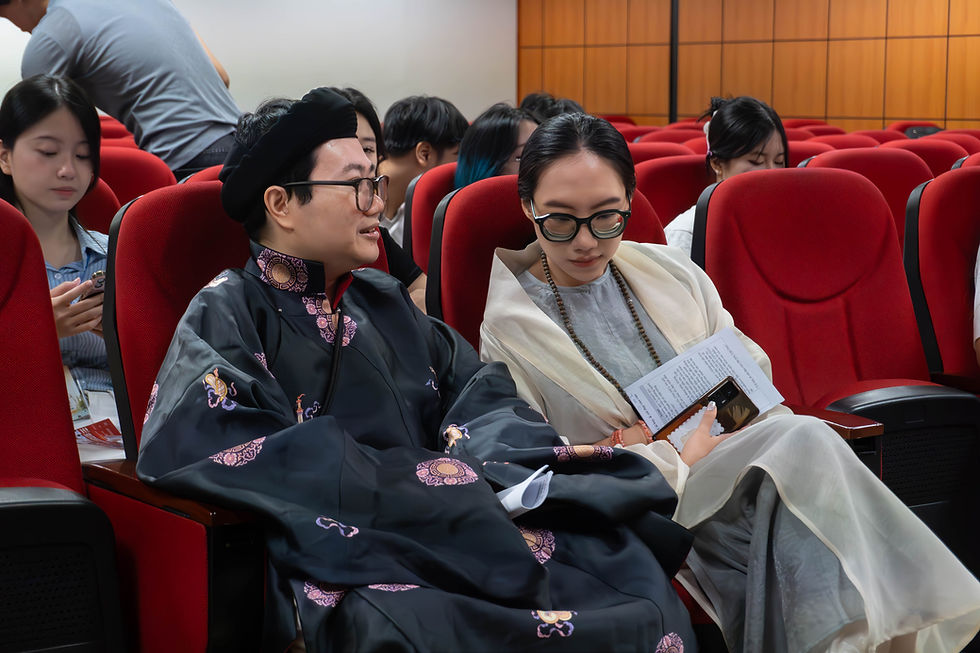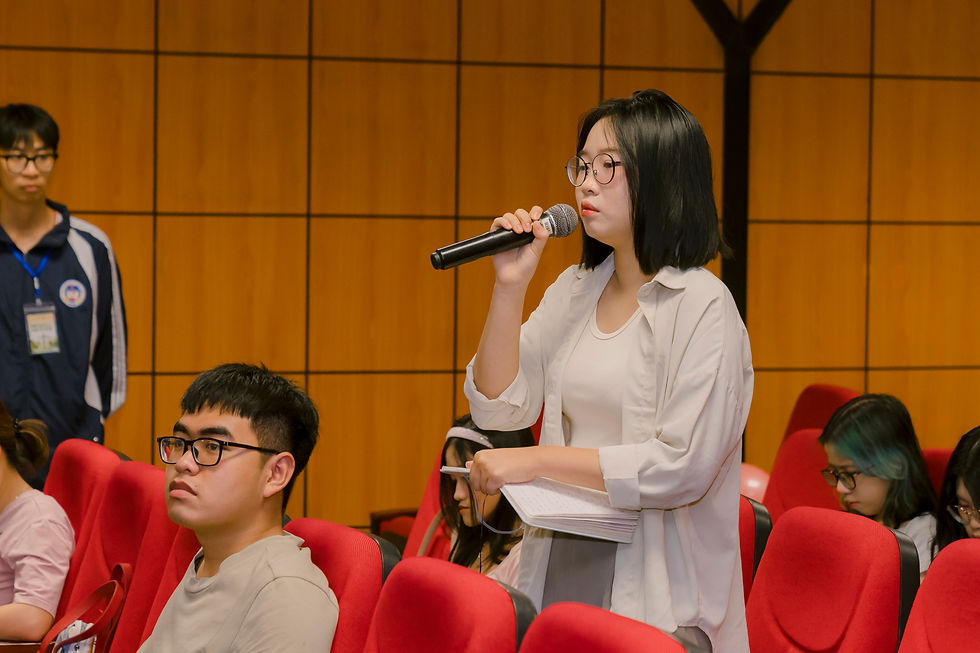Culture as a Living Resource for Creative Business and Community Development
- Thu Quỳnh Ngô
- Jul 27
- 6 min read
Updated: Aug 13
“The Charms & Beauty of Vietnamese Culture” spotlights sustainable cultural industries, heritage pride, and creative tourism initiatives.
Hanoi, July 27, 2025 — As part of the ISME Business Case Debate Contest 2025, the talkshow “The Charms & Beauty of Vietnamese Culture” brought together cultural researchers and creative entrepreneurs at the National Economics University to share strategies for preserving and revitalizing Vietnam’s indigenous heritage.

Speakers explored the foundations of culture and sustainable development, ways to grow cultural industries without losing authenticity, and real-world projects such as the Hanoi City Map cultural tourism initiative and the book Kỳ Công Diệu Nghệ (provisional translation: Marvels of Vietnamese Ingenuity), which chronicles Vietnam’s historical technological achievements.

SPEAKER INTRODUCTION
Mr. Nguyễn Ngọc Phương Đông
· Cultural and historical researcher
· Co-founder of responsible groups and platforms dedicated to the study of Vietnam’s ancient history and culture, such as Đại Việt Cổ Phong, Vietnam Centre, and Vương Sư Kiên Duệ.
· Author of “Kì công diệu nghệ- Một số kĩ thuật và công nghệ trên dải đất hình chữ S trước thế kỉ XX” (Marvels of Vietnamese Ingenuity – Selected Techniques and Technologies on the S-Shaped Land before the 20th Century), and “Lôi Động, Tinh Phi” (A Study of Vietnamese Firearms)
· Co-author of “Mình đồng da sắt- Lược sử về giáp trụ Việt Nam” (Iron-Clad – A Brief History of Vietnamese Armor), and “Dệt nên triều đại” (Weaving Dynasties).
· His major research focuses on the history of customs, traditional attire, and weaponry
Ms. Lê Ngọc Hà Thu
· Multidisciplinary creator with a focus on sustainable development
· Co-founder of XAVAN Inc. – an R&D organization in the cultural sector
· R&D Team Leader of Hanoi City Map project
· Global member of the Next Gen Assembly 2025

PART 1: DEFINITIONS
1. What is the culture of a civilization, and what specifically is indigenous culture? How can we distinguish indigenous culture from the general culture/civilization of humanity?
Mr. Đông: Culture is the crystallization of both the material and spiritual life of a nation — religion, customs, attire, architecture, cuisine, tools, and production methods. Each region of the world has its own civilization, for example: East Asia, India, Western Europe, Pre-Columbian Americas. Each contains multiple countries sharing many common features.
Within East Asia (Vietnam, China, Korea, Japan), religions, scripts, and customs overlap — but each nation has its own characteristics shaped by its living environment, what our ancestors called “great similarities, small differences” (đại đồng tiểu dị). For example, Vietnam’s subtropical climate leads to a rice-based diet, elephants for royal transport, and betel-chewing with blackened teeth; Korea’s colder climate means eating rice, wheat, and barley, and having no elephants. These small traits clearly distinguish each nation.
2. What is sustainable development? Are there new theories or ideas in the sustainable development mindset to strengthen an indigenous community?
Ms. Thu: The definition of sustainable development changes over time, but at its core it can be summed up with 3Ps:
· Planet: Earth is where we live, where all we discard is stored.
· People: Humans are part of nature, not machines.
· Profit: Profits from business models should serve people and the planet.
New definitions will keep emerging, but the foundation is always balancing these three factors.
3. How can we develop the cultural industries sustainably?
Official Definition of Cultural Industries by the Government of Vietnam:
"Cultural industries” is a term used for industries that combine creativity, production, and the commercialization of creative content. This content is essentially intangible and cultural in nature, protected by copyright law, and expressed in the form of products or services. On September 8, 2016, the Government issued the Strategy for the Development of Cultural Industries to 2020, with a Vision to 2030, which promotes the development of 12 sectors: Advertising; Architecture; Software and video games; Handicrafts; Design; Cinema; Publishing; Fashion; Performing arts; Fine arts, photography and exhibitions; Cultural tourism.
Source: General Information Portal of the Central Committee for Policy and Strategy.
Mr. Đông: For sustainability, a business needs “substantial capital” — not just money, but knowledge and cultural capital. If cultural exploitation is shallow (relying only on images like nón lá - conical hats, phở, bánh mì, lotus-embroidered áo dài), ideas run out quickly. Digging deeper into Vietnamese decorative arts, attire, or culinary philosophy offers endless stories and fresh products. For example, adding cultural details like the barefoot custom or dragon tattoos into films or games allows for clean, captivating communication without relying on scandals or celebrity hype.
Ms. Thu: We must avoid “short-term exploitation” and have a plan to both use and replenish our “cultural capital”. In Sapa, over-tourism — mainly from lowland Kinh people — has stripped away much of the original cultural identity. Business without two-way engagement with local people and culture risks erasing the soul of a place.

PART 2: PRACTICAL EXAMPLES OF BUSINESS IN CULTURAL INDUSTRIES
1. What are the difficulties in integrating cultural elements into business, and how can businesses overcome them?
Mr. Đông: Many companies enter the cultural industry due to trends and policies but lack prepared personnel and data. Financial pressure forces quick product releases without thorough research, leading to cultural errors. The solution is having a close advisory team providing solid knowledge and materials to defend cultural elements in communication. Recently, awareness among companies has improved, resulting in better cultural products.
Ms. Thu: The Hanoi City Map (HNCM) project by XAVAN Inc. & FME designs in-depth, educational cultural tours. The hardest part is balancing “how much culture” with entertainment value. Our solution: divide tours into Locaventure (for the general public — multi-sensory cultural experiences, light on information) and Eduventure (for students — rich in knowledge). Cultural experiences must be enjoyable; when people have fun, they’ll naturally want to learn more.
2. How can we apply indigenous culture in economic activities without over-commercializing it and losing authenticity?
Mr. Đông: A deep understanding of culture prevents distortion. Some see áo tứ thân or áo bà ba as “not attractive enough” and make them flashier or more revealing, which leads to inaccuracy. In contrast, brands that research thoroughly have shown that Vietnam’s traditional attire is inherently stunning, on par with Korea, China, and Japan. They have a vast repertoire to work with and countless authentic stories to tell — like Vietnam once being a silk powerhouse in the 16th–17th centuries, with its silk sought after by the West and Japan. Such stories spark pride and curiosity in customers.
3. How can we encourage young people, especially students, to engage in preserving and spreading indigenous culture through economic activities?
Mr. Đông: When young people see the beauty of Vietnamese culture firsthand, they’re naturally drawn to it. For instance, in 2019, with Vietnam Centre, we held a Vietnamese Nguyễn Dynasty costume exhibition in Sydney that attracted over 1,000 visitors. Many young overseas Vietnamese who previously felt disconnected from their heritage became motivated to learn and even organized heritage tours back to Vietnam. Domestically, the “Bách hoa bộ hành” (provisional translation: Hundred Flowers Parade) of traditional costumes started with 100 participants but now attracts nearly 2,000, becoming a highlight for Hanoi tourism and a curiosity for foreign visitors.

PART 3: FUTURE-ORIENTED INITIATIVES
1. Please share your motivation behind an innovation in history education for children: Kỳ Công Diệu Nghệ (provisional translation: Marvels of Vietnamese Ingenuity) by Mr. Đông, co-published with Wing Books, Kim Đồng Publishing House.
Mr. Đông: To develop a creative economy based on science and technology, we must inspire pride in the younger generation. Kỳ Công Diệu Nghệ presents 30 Vietnamese technical and technological innovations documented by foreign sources, showing our historical leadership:
17th century: Cham people bred a quick-ripening, drought-resistant rice variety; the Song Dynasty imported it to relieve famine and even planted it in the imperial palace.
10th century: Invented the flamethrower, later introduced to China.
19th century: Under Emperor Minh Mạng, Vietnam mastered steamship building before China and Japan by over a decade.
The book aims to instill pride and confidence in youth, using cultural and historical heritage to fuel modern innovation.
2. XAVAN Inc. and the Hanoi City Map (HNCM) project are aiming for an innovation in cultural tourism. Ms. Thu, could you share about the collaboration between XAVAN Inc. & FME — a Hanoi-based research and design organization for cultural products, and the other a long-established, reputable sustainable travel company from the Mekong region?
Ms. Thu: Tourism is a prime sector for developing cultural industries. Beyond sightseeing and leisure, there’s tourism for academic and research purposes. HNCM aims to convey the charms of Vietnamese culture through experiences for both international and domestic visitors. For example, the “Discovering the Old Quarter” tour helps visitors from other regions understand the culture of ancient Thăng Long – Kẻ Chợ. Educational versions allow participants to study heritage management, such as how the Quảng Đông Assembly Hall has been repurposed into the Cultural & Art Centre at 22 Hàng Buồm. HNCM’s guiding spirit is that: “When visiting a new land, be both a guest and a student — learn the good, feel the beauty, and enrich yourself in the process”

The talkshow closed with a shared message: culture is not only a legacy to be safeguarded, but a living resource for creativity, education, and sustainable growth.



Comments